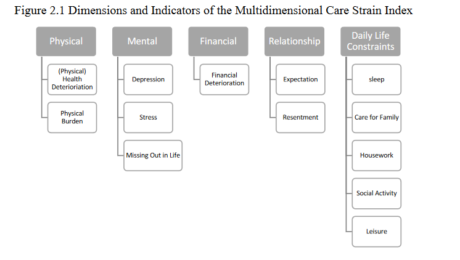Measuring the Overall Strain of Caregiving: A Multidimensional Approach
Providing care for others, especially for the frail elderly and young children, is one of the most important forms of human work that sustains our existence. However, caregiving is also often challenging and strenuous. Many informal caregivers are known to suffer negative physical, emotional, and social outcomes, and are at risk of losing their own health and well-being. Fengler and Goodrich, for example, refer to the wives of frail elderly men as ‘the hidden patient,’ warning the negative consequences of caregiving on informal caregivers. Since the 1980s, several instruments have been developed to measure the strain of caregiving among informal caregivers. Some measurements such as the Zarit Burden Interview and the Caregiver Strain Index have been applied more widely, while other measurements have been used for more specific groups of caregivers (e.g., who takes care of the elderly with cancer). Although these measures provide valuable information on various dimensions of caregiver strain, they are not sufficient to assess the overall level of strain experienced by caregivers. In most cases, these measurements consist of a list of questions or statements about the caregiver’s burden; the sum of the answers is then used to indicate the level of burden/strain experienced by the caregiver. Although useful, a simple non-weighted sum of answers may not be an accurate representation of the overall strain. For instance, two groups of caregivers may have the same average total strain score, but one group may consist of all caregivers who suffer strain in some statements, while the other group may have half of the care givers who suffer strain in all statements and the other half who do not suffer strain at all. While the marginal distribution may be the same, the joint distribution may not, and this has an important policy implication.
Adapting the Alkire-Foster method developed to measure multidimensional poverty, Jun et al (2019) propose a threshold-based approach to measuring overall caregiving strain that accounts for the multidimensionality of the caregiving experience. The approach is based on the premise that as in the case of poverty, the negative consequences of multiple strains attached to caregiving would be greater than the sum of their individual effects. The authors first identify the dimensions and indicators that are known to be important consequences of caregiving, such as physical, psychological, financial and relational strains, and daily life constraints. They then count the overlapping strains a care giver experiences under different indicators of caregiver strain. Next, they identify caregivers who are experiencing strains above a specific cut-off point as multi-dimensionally strained. This measure is tested using the data from the newly collected Survey of Eldercare and Childcare in Korea 2018, exploring whether receiving support, help and appreciation may be associated with reduced chance of being multi-dimensionally strained. By providing an overall measurement that identifies caregivers with multiple strains, the authors examine 1) which group of caregivers are more likely to be at risk; 2) which dimensions do most caregivers suffer strain; and 3) what may be potential buffers for caregiving strain.
This paper will be available December 2019
This blog was authored by Jiweon Jun, Ki-Soo Eun and Ito Peng
- Published in South Korea, Understanding and Measuring Care
- 1
- 2

